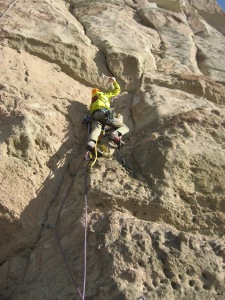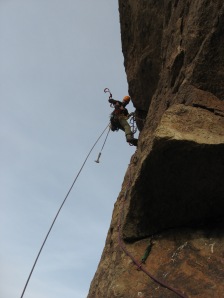Louisiana Gulf Memories
June 11, 2010
Though I can’t remember exactly where we were, I do remember the tremendous fishing. I remember my dad and the early morning wakeup and the long boat ride in the salty morning air. I remember the hilarious and warm charter boat captain. Some of the best fishing we had was directly off the oil rigs. When we got there the workers would play music over the loudspeaker system and we would pull up red snapper after red snapper. I definitely remember the delicious eating in the weeks after we returned to Chicago.
In the ensuing fifteen years I’ve often thought about going back, and am disappointed that I never did. The Gulf is devastated now. While the direct responsibility lies in the hands of BP, their subcontractors, the MMS, and the rest of those that pushed for lax regulation of the oil industry, the truth is that we all own it. Oil is involved in nearly every facet of our lives. I’m not sure where our country and our world goes from here. It is a finite resource and will at some point run out. The fact that BP was drilling in water as deep as they were is indicative of the fact that we’ve already drilled and recovered the easy to access oil fields. The time to start transitioning away from oil was thirty years ago. That didn’t happen, obviously.
The harder and more difficult the oil is to extract, the more likely events like the Deepwater Horizon spill are to happen. Perhaps as a society we’ve become willing to accept the destruction of the Gulf of Mexico as collateral damage resulting from our way of life. The ridiculous slogan “drill, baby, drill!” makes me uncomfortable. It makes me uncomfortable because I want to abhor those people, but I am forced to look at my own actions and realize how big a part of the problem I am.
Last Tuesday morning I drove an hour and a half up to Mt. Hood by myself to go skiing for a few hours and thought about what an excess that was. And I thought about the thousands of miles I’ve driven and flown over the last ten years to go climbing. And all the petroleum based products, from my synthetic clothing to my plastic helmet, that I use.
The truth is that I feel like a hypocrite. I am disgusted by our dependence as a nation on oil, but am myself an addict. I don’t WANT to stop. I love climbing and skiing, traveling and getting out and more often than not oil is involved in some way. But I can still smell the Gulf air and I remember the fishing and the wildlife, the beauty of the bayous, and am deeply saddened when I see pictures of the devastation. Is it worth it? Will we be able to escape our oil dependence before it’s too late? I’m not entirely sure that we can, but I do know that in order to stay sane I’m going to have to do something to change my own relationship to oil.
Dean Fry and Smith Rock Grade VII
March 8, 2010
My friend Tyler Adams is part Smith Rock historian, part old route restorer, and full on lover of the perversity that is Smith adventure choss climbing. Tyler does a lot of work replacing old bolts and late last year he told me about a route he had re-bolted above the oft climbed moderate Bunny Face. The route, Methuseulah’s Column, sounded like everything that Bunny Face is not: runout, dirty, scary. In fact, Watt’s original guidebook describes it as, “Plagued by bad rock and poorly-spaced bolts, this unlikely line was the first bolted face in the Dihedrals. Avoid Methusuelah’s if you want to live to a ripe old age.” Perfect!
In late November I headed up Bunny Face with the intention of checking out Methuseulah’s. The runouts were intimidating from below, but feeling strong I headed up and soon found myself clipping the anchor with relief. The climbing was bold and serious, even with new 1/2″ bolts and modern sticky rubber. The route was visionary when Dean Fry established it in 1973, on lead, well before bolted routes became the norm at Smith. Fry established a number of other serious routes in the park. Most have seen few ascents and many haven’t been repeated, while some have become very classic. His most repeated first ascents include New Testament, Zebra and Moonshine Dihedral. He also made the first free ascent of the ultra-classic Karate Crack.
In early February Tyler and I headed to Smith to attempt a new route. A bird closure thwarted that effort and with heavy packs loaded we headed up to The Wombat to attempt an old Dean Fry aid route called C.L. Concerto. The route takes an amazing line up the impressive Northwest face of the formation. Not having much experience with aid climbing I found the thin crumbly seams of the first pitch a little worrisome. Forty feet up I blew a large beak and lobbed twenty feet onto a cam , ripping an entire screamer. Short February days and cold conspired against us. The sun disappeared behind the Cascades and it was time to head down. The following two days brought more cold and snow and no possibility to climb. Two weeks passed and we headed back to Smith hoping to finish the route. I completed the first pitch and the following day Tyler began the crux A4 section. Very thin, steep nailing on horribly hollow rock had me a little frightened just belaying. I was happy for the new half-inch bolts in the anchor and cleaning the pitch I was deeply impressed by Tyler’s aid prowess. Once again the sun began to set and we fixed ropes. Another two weeks passed and we returned, jugging back to our high point. I began to lead the final pitch. A static fall onto a good pin when my third piece ripped hurt my psyche. I was climbing slowly and the cold and wind combined to create a most unpleasant experience. With relief I pulled over a bulge and began easy but runout free climbing to the top of the ridge. As the sun set Tyler finished cleaning and led off towards the summit of The Wombat. It took us five weeks to make the third ascent of C.L. Concerto and standing on the summit was quite satisfying.
From Top: Nailing on the first pitch, A4 second pitch, finishing second pitch, Tyler raps, third pitch
Dean Fry was pushing the limits of Smith climbing during the short time he was active there. Almost 40 years later his climbs remain an impressive testament to his strength and vision. In 1973 heading back from Smith to his home in Corvallis, Fry was tragically killed in a car accident. The routes that he left us are a gift and his memory will live on in the climbers who choose to follow in his footsteps.
Getting Out
October 28, 2009
I groaned and rolled over as the alarm released a series of deafening high pitched beeps into my sleeping ears. 3:00AM, why am I doing this to myself? I shut my eyes and drift back to sleep. Half an hour later I wake up and realize that I’m supposed to be across town at Marcus’s house in two minutes.
We roll through Hood River on the way to the North Cascades. “It’s not raining now,” says Marcus.
Hours roll by under an increasingly menacing sky. The forecast calls for a “significant hydrological event” on Friday with up to an inch of rain, then the models show the weather clearing for a brief window on Saturday, and then more crap weather on Sunday. If we can just approach during the rain on Friday, we’ll be all set to climb the route when the weather window materializes on Saturday. Desperation really, but such is the mindset of the North Cascades alpinist come autumn.
Marcus tells me, “You know, when you didn’t show up at 3:30 I thought maybe you had decided to bag it and went back to sleep. I was getting ready to do the same thing when you showed up. It’s like a game of chicken, I’ll go if you go…”
The rain in Leavenworth is torrential. We stop at the faux Bavarian pharmacy and buy four dollar ponchos.
We keep driving and the rain doesn’t stop. The gray sky is oppressive. The rain isn’t warm. It is a bone chilling, hypothermia inducing type of rain. We should be sleeping in and then hanging out at a coffee shop with our significant others. Instead we’re at the trailhead packing.
Marcus puts his poncho over his head and pack. I laugh and throw mine on. Marcus says, “No pictures.”
We walk up the trail for miles. It isn’t long before everything is soaked. The pitter patter of raindrops on cheap plastic occupies my thoughts. We arrive at an alpine meadow not far from our objective and set up the tent. The mountains are socked in, their tops hidden under a shroud of gray.
That night the rain never stops. It pounds our small nylon shelter until water starts to sneak in the seams. Drifting in and out of sleep, I am annoyed by the fact that my butt is wet. Eventually the loud rain gives way to the soft whisper of snow hitting tent fly.
We wake up with the alarm but the stubborn gray skies remain.
Perpetually Injured: 2006-2009
June 2, 2009
I’ve spent a lot of time thinking about injury over the last few months as I have been recovering from my various ailments. As I was going through photos on my computer I found a few that provide a nice time line for some of the various injuries I’ve had over the last three years. None have been extremely serious, but all have caused disruptions in the momentum of my training and climbing. It is frustrating to start feeling good again and then be out of the game for a couple of weeks or months due to an injury that quite possibly could have been avoided.
February ’06- Frostbite due to unplanned bivy
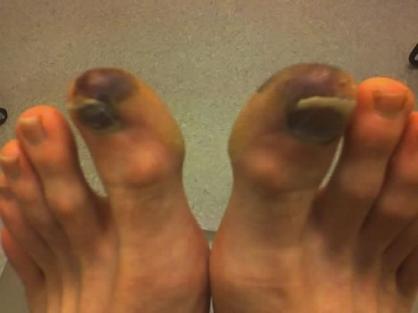
April ’06- Sprained neck due to avalanche
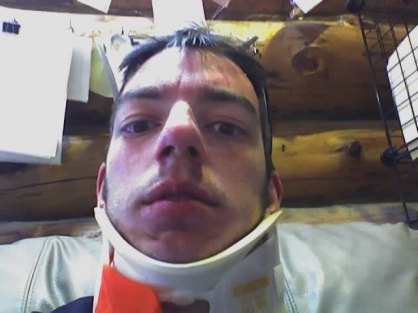
January ’07- Bursitis in my knee from slamming it directly into ice after falling off a bolted M-climb.
May ’07- Frostbite pretty much all fingertips
January ’08- Hyper-extended elbow from fall bouldering in the gym
May ’08- Sliced the pad off my right index finger three days into a three week climbing trip to Yosemite. Left wrist starts to hurt for some unknown reason.
April ’09- After almost a year have surgery on said wrist.
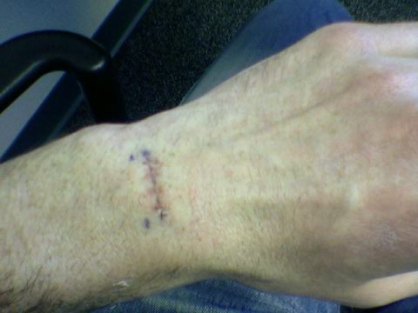
May ’09- Fall down walking downhill in the Gorge and slice open hand on a sharp rock
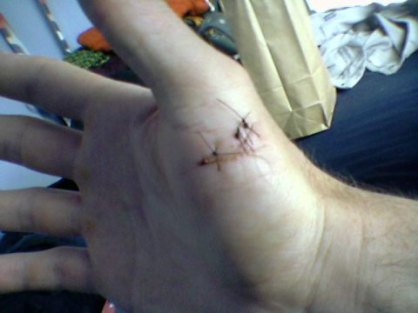
I am back on the road to recovery and determined to climb, train and walk smarter. Perhaps if I can stay healthy for a while I can acheive some of the goals I have set for myself. Last weekend I had an excellent trip to the North Cascades with a new climbing partner, it was a great and motivating way to start out the season!
Obama MUST Implement the Climbing Resource Assistance Program
January 20, 2009
While nearly a trillion dollars will soon be unleashed into the American economy in the form of a wide ranging stimulus package, thus far none of this money has been allocated to the climbers of the United States and this is an outrage. Therefore I propose the Climbing Resource Assistance Program. The program’s main goals will be to:
- Employ as many as 50,000 young men and women as government climbers
- Develop a corp of world class American climbers
- Repair and build trails and structures
- Replace dangerous fixed equipment on climbs nationwide
- Stimulate the outdoor industry
- Appoint a Climbing Czar to oversee the program
The core of the CRAP is the mission of job creation. By creating 50,000 new jobs CRAP will provide young people with an opportunity to work to better America while pursuing their passion. Climbers employed by the program will be expected to climb a minimum of three days a week, while devoting three days a week to environmental projects such as: trail building, habitat restoration and trash cleanup. Most importantly the program will keep potentially revolution prone young men and women off the streets and busy working towards a better America.
Climbing areas across America are littered with rusty bolts and manky fixed pins. These ticking time bombs represent a grave threat to the climbers of the United States and need to be replaced. Together CRAP climbers will do their best to eradicate the looming menace of failed fixed gear.
The struggling outdoor industry will also benefit from the CRAP, as more climbers require more gear to go about their jobs. Saving jobs is our priority and by keeping the outdoor industry alive we are preserving an important part of the private sector. The used van market will also see a boom as newly employed government climbers will need places to live.
There are a number of details yet to be worked out. The Climbing Czar will have the serious task of shaping the CRAP into a viable program, so their appointment must be considered carefully. The appointment of the Climbing Czar will show that this administration takes the CRAP seriously and is willing to work on development of this innovative plan.
What is good for American climbers is good for America. Passing the CRAP will allow American climbing to retake its rightful place on the world stage by nurturing the next generation of climbers and preserving our climbing areas for decades to come. With a proposed budget of merely $100 million, I expect that Obama will see what a deal this program is and implement it in time for the spring Yosemite season.
A Quick Look at Depression Era Mountaineering in the Northwest
January 11, 2009
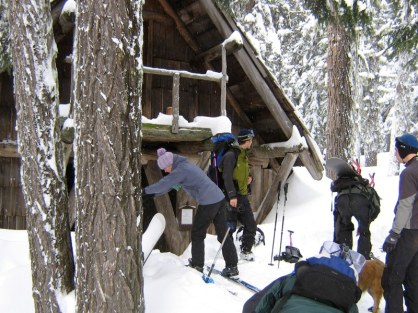 Tilly Jane Ski Cabin circa 2007: a depression era building project that is still very much in use today
Tilly Jane Ski Cabin circa 2007: a depression era building project that is still very much in use today
Oregon’s Mazamas climbing club maintain a library at their Mountaineering Center in Portland. I visited the library and spent a few hours looking through their old journals. Reviewing old climbing publications is always an interesting exercise for those interested in the sport. They really capture the time period and as original sources give a historical perspective that can’t be found elsewhere. The grainy black and white photographs of happy young men and women in the backcountry exemplify the freedom found in the mountains and it is easy to feel a connection to these people. Love for wild places transcends time and they remind me of my friends and I, minus the wool clothes and hemp ropes of course.
In the journals there was little direct mention of the economy or much written that would indicate there was a depression happening. I suspect that a glut of bad news circulating, people most likely wanted to keep economic news out of their climbing news. The Mazamas annual publication mostly contains articles on climbs in which club members participated. Most of the reports during the years I reviewed were local climbs in Oregon and Washington, as well as some documented trips to Canada and the Tetons. This isn’t all that surprising in that during this time period much of the Cascades were still unexplored. There were also a number of research related reports including such topics as: A Photographic Survey of Glaciers and Mountaineering Physiology.
In the December 1932 publication, Margaret A. Redman wrote in the article The Lure of Other Lands that there was, “a movement towards private jaunts and journeys, alone or with other clubs, North to Alaska, South to Mexico, Central and South America, through the Mediterranean Sea, to Africa, around the world- where not? And why not? Since we come back satisfied that, for us, ours is the best.” She mentions that perhaps this is because of depressed prices. This is also evident in the 1931 American Alpine Journal, where the editor writes, “The Himalayas are becoming more popular. We read of at least four expeditions now under way for climbing there next summer.” More than anything this highlights the deflationary nature of the Great Depression. Those that had jobs and money were doing well enough financially to have the luxury of traveling abroad for the seemingly frivolous activity of climbing mountains. Those without were having The Grapes of Wrath experience.
There were a few other interesting points of note: a change in the kind of advertising in the Mazamas annual publication and the steady number of club members. In the 1930 publication there were a variety of advertisements for services ranging from sheet metal workers to florists to hardware stores. By 1938 the bulk of the advertisers were skiing and outdoor retailers and service providers. The other obvious statistic to look at was club membership. In 1930 the club had 627 members. By 1932 that number dropped to 612. Unfortunately numbers were not available for the next five years, but by 1938 club membership had increased to 698. It is interesting that throughout the 30’s there seems to have been little fluctuation in the number of club participants.
Not necessarily related to the economy, but an interesting case of what is old is new again, I came across at least three articles dealing with concern over glacial recession. In the December 1938 annual publication Kenneth N. Phillips writes in an article entitled Our Vanishing Glaciers, “While we in the Pacific Northwest are in no danger of suffering glacial bankruptcy, it does seem worthwhile to take some inventory of our glacial assets at this time.” I suspect that if Mr. Phillips saw our glaciers today he might be surprised at the extent they have changed.
Most climbers today (myself included) are not part of regional climbing clubs. I don’t doubt that there were a number of climbers operating outside of the Mazamas in Oregon in the 30’s. Therefore I don’t believe that the Mazamas journals provide an exhaustive record of everything that was going on during this time period, but they do give us an idea of the level of activity in the region. I would be interested in knowing the number of active Oregon climbers who were not members of the Mazamas and what they were doing in the mountains.
Another lasting impact the Great Depression had on climbing were building projects stemming from Roosevelt’s New Deal. For the last 70 years climbers and skiers have benefited from depression era construction of trails, huts and other structures in the mountains. The Civilian Conservation Corp had a number of projects around the state. Probably the most recognizable CCC project in Oregon is Timberline Lodge. Other construction on Mt. Hood included the Timberline Trail, which circumnavigates the mountain, and also the Tilly Jane trail and ski cabin which are both still enjoyed by backcountry enthusiasts.
Climbing for sport has been around since, at the latest, 1786. People have continued to climb despite over 200 years of human history and all the turmoil and tragedy associated with that time. The sport has survived depressions before and will continue to survive. With America’s new financial reality perhaps a new Civilian Conservation Corp will be created that will repair neglected trails and build new hut systems, allowing those that love the mountains to live and work in them. Climbing may begin to seem like an impossible luxury to those struggling financially, but those that can will always find a way to get into the mountains.
Arctic Blasted
December 30, 2008
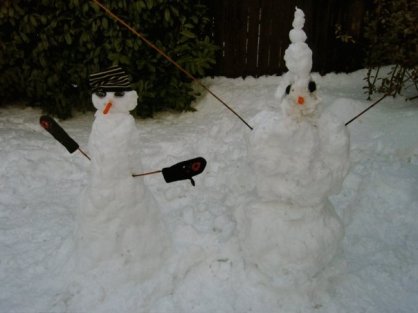
Situated between Oregon’s Coast Range and the Cascade Mountains, the Willamette Valley has predictable weather for most of the year: nine months of rain and generally three months of really nice weather. Typically there will be a week or so of cold temperatures sometime between December and February. It might flurry in Portland briefly, but rarely does snow accumulate in any significant amount. When an inch falls and sticks around, schools close and the city shuts down for at least two days. It’s a pretty reliable indicator that for every inch of snow two days of school are canceled. The local news stations freak out and go on 24 hour weather coverage. Having grown up in the Midwest, the whole thing is pretty ridiculous. Pulling your car out of the driveway during one of these storms is tantamount to playing Russian Roulette. Four wheel drive vehicles careen down the roads thinking they are invincible, only to realize that having four wheel drive doesn’t mean shit when trying to stop. Last year’s snowy week produced this gem of a video. With over a million views on Youtube it is a modern classic.
This year the storms hit at the most opportune time: Christmas! The cold weather started the week before schools released for Christmas break. Pretty awesome when the paycheck depends on schools being open. It barely snowed that week and the streets were fine, yet somehow it was deemed necessary to shut them all down. Go figure.
The real snow didn’t start until the following week anyway. This is my sixth winter in Portland and until this year I’ve never had to shovel snow. It dumped and dumped loads of snow further exacerbating the terrible driving conditions and shutting down stores, restaurants and the airport. My dad made it into town, from Chicago, for a nine day stay. Sarah was set to fly home to Boston on the Sunday before Christmas but her flight was canceled. Tuesday we tried to get her out again. Miraculously she was able to get on a flight to Boston with a connection in Chicago. I drove away from the airport feeling that it was too good to be true. As soon as I walked in the door the phone rang and Sarah told me the flight was canceled. I once again braved the treacherous roads to retrieve her from the airport. On the car ride home she told me she had met people who had been at the airport for three days. When they announced the flight cancellation there was much swearing, some puking and one fainting pregnant woman. It sounded intense. Back to the house for us! I’m not sure if you’ve ever been snowed in with two other people before, especially one pissed off girlfriend that was very much looking forward to going home for the holidays, but I don’t recommend it. That’s enough about that.
The most exciting part of cold weather events in the Portland area is the ice climbing opportunities that present themselves when the Columbia River Gorge freezes. This year proved to be a long freeze with a lot of ice coming in, but very unproductive for me. My bum wrist, general lack of fitness and family obligations prevented me from getting out all but one day early in the freeze. That day mostly involved driving and walking around looking at partially frozen things until the temperatures rose and it stated to rain in the afternoon. Eventually a lot of climbs came in and the ice got fat, but of course as soon as they did the temperatures warmed and the rains came. Such is the life of an Oregon ice climber.
A day and a half of rain wiped out what snow remained on the ground, erasing the evidence of the epic arctic blast of ’08. It is now as if it never happened and we are returned to our regularly scheduled program. Enjoy the New Year, another arctic blast lurks just around the corner.
Injury and Enlightenment: The Motivationless Year
December 12, 2008
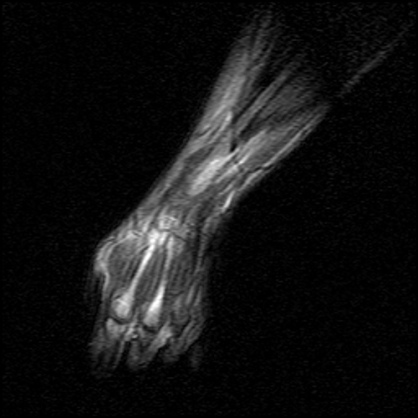
At 27 I’ve been climbing almost ten years and in that time I’ve made an astounding number of life decisions based on my desire to be near rocks and mountains. I chose my college based almost solely on its location in Southwest Colorado at a place where the high desert meets the mountains. When I moved to NYC for grad school the first thing I did was go to Central Park to find the bouldering and spent as much time there as I could. I didn’t last long in New York before the dearth of mountains got to me and I landed in Portland.
I finished a graduate degree in teaching, as much for the potential time off as for anything else. I discovered substitute teaching as the ultimate dirtbag job. Flexible, yet well paying, it was easy to extend vacations or make your own when conditions seemed good. Summers off. Europe, Alaska, Mexico, I traveled to just about every major climbing area in the West and some in the East. I thought about climbing constantly and when I wasn’t away climbing I was training for it or making plans to do it. The pattern went on for years. Through relationships and breakups, the deaths of friends and family members, jobs and living situations, climbing was always a comfortable constant.
And then something happened. Inexplicably I started to lose my motivation. I started questioning why I was spending so much time doing something so seemingly irrelevant. I was giving so much to climbing, what was I getting in return? It was in the midst of this existential examination that I injured myself. The pain in my wrist started out small. I took it easy for a while hoping that it would start to heal. I couldn’t help but think that my mental malaise was manifesting itself in some physical form. Perhaps there was no wrist injury, but some unseen force trying to teach me a lesson.
If there was any lesson I was too stubborn to pay attention. In May I had a difficult trip to Yosemite. I couldn’t find a partner, the weather sucked, my attitude was terrible. I ripped off one of my index finger pads the first day climbing. This trip was supposed to be a warm up for the Alaska range a month later, and my big ambitions collapsed along with my motivation. In three weeks I had climbed four pitches and done a handful of bouldering problems.
As soon as I got home I called my Alaska partner. I had never bailed on a big climbing trip before, especially the week before traveling. He was upset but ultimately somewhat understanding. He had given up a lot to go on the trip and I felt terrible, but I also knew that I couldn’t do it. I couldn’t spend all that time and money only to sit on a glacier for three weeks unable to climb, my brain and my wrist telling me, “I told you so.” I launched a campaign of self pity and wasted the rare sunny days of a Portland summer on the couch feeling sorry for myself.
Six months later and I haven’t climbed since, but I have rediscovered really nice parts of my life that I had forgotten existed. I’ve lived without thinking about climbing constantly , I moved in with my girlfriend, I’ve done a lot of beer drinking and fly fishing. I’ve seen my friends more (although still not enough)…
I finally had an MRI on my wrist. The doctor discovered a cyst in the joint and some ligament damage. I have an appointment with a surgeon next month. We’ll see how it goes, but regardless it feels good to have some solid evidence of what’s wrong and know that there’s something that can be done to fix it.
It wasn’t long ago that I flirted with the idea of giving up on climbing entirely. But, as it does every year, fall slowly fades into winter and I remember what it feels like to swing an ice tool. I miss the feeling of early morning starts and late, exhausted finishes. I miss being scared shitless. I know that I won’t stop climbing, probably for as long as I can keep it up. I also know that climbing isn’t the only path, and that an unwavering, fundamentalist belief in anything ultimately leads to disappointment for all parties involved. Climbing is an amazing, unique pursuit, but for all it teaches us it can’t make a life whole. I’m glad I’ve gained the wisdom to see that.
The Limerick that did not Win my Climbing Partner and Me new Boots in a Writing Contest
April 8, 2008
In Alaska I had a partner named Marcus,
On the mixed he moved like a farkas,
On the summit in a storm,
Without hope is the norm,
I know with him I will not be a carcass.
(Farkas means “wolf” in Hungarian)

